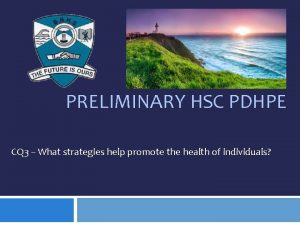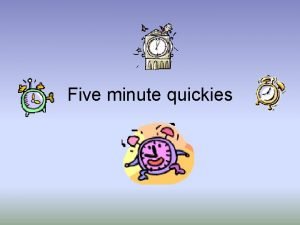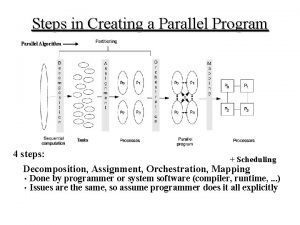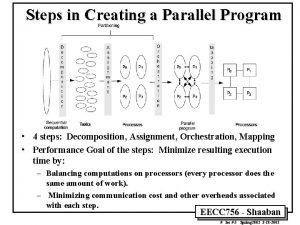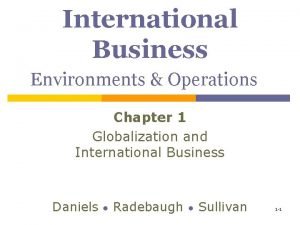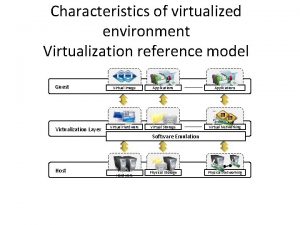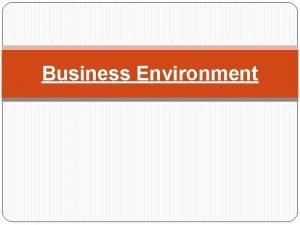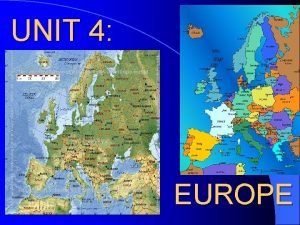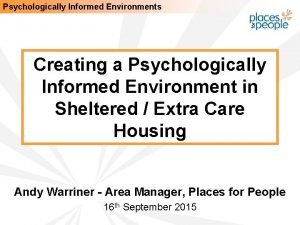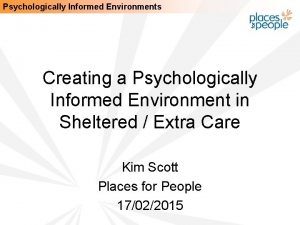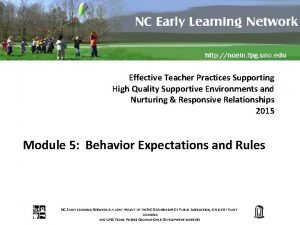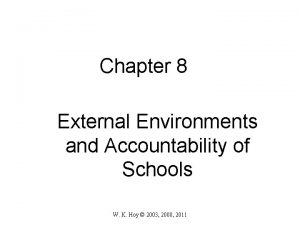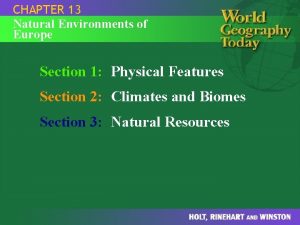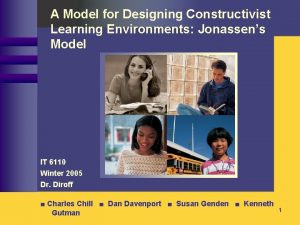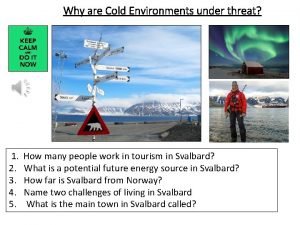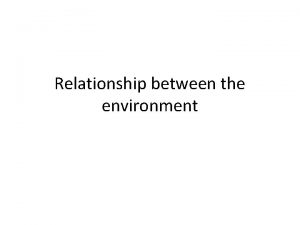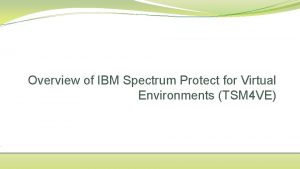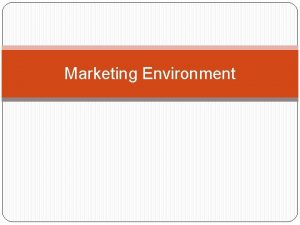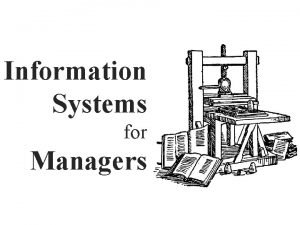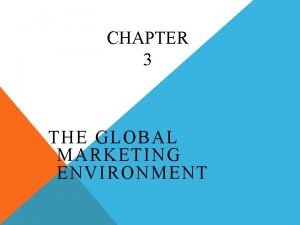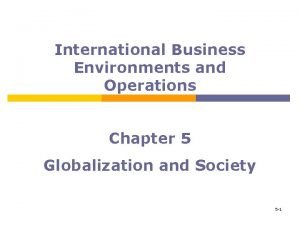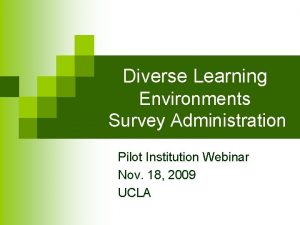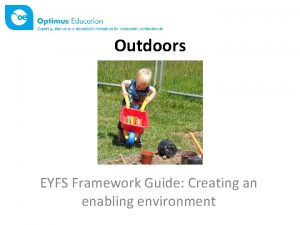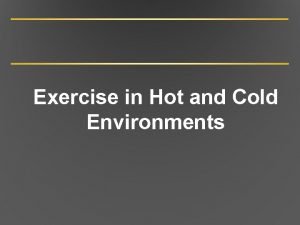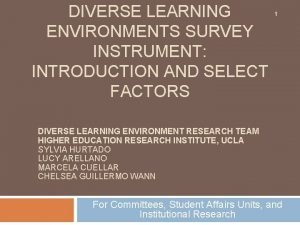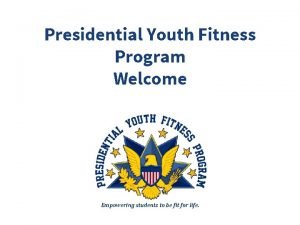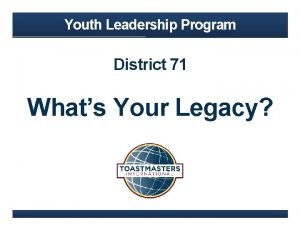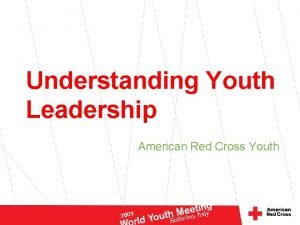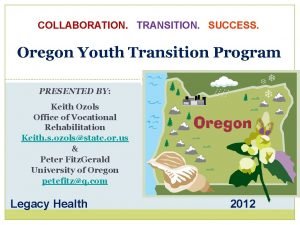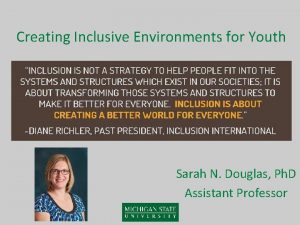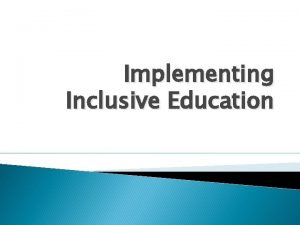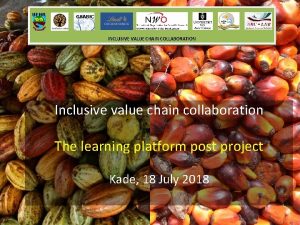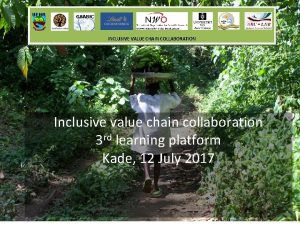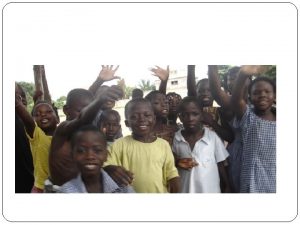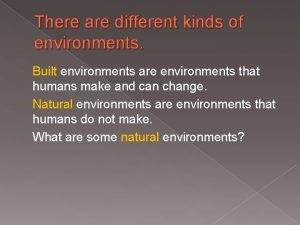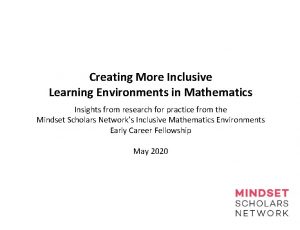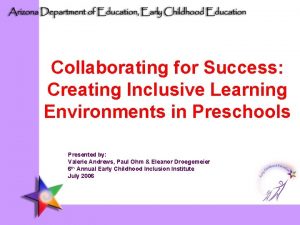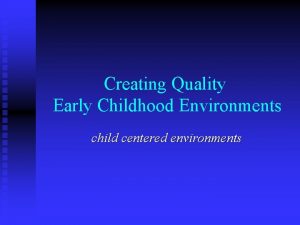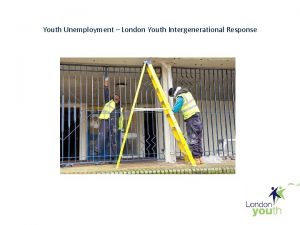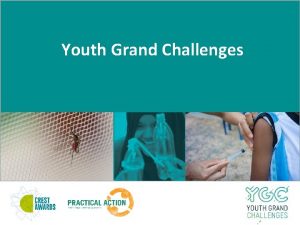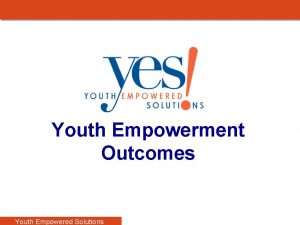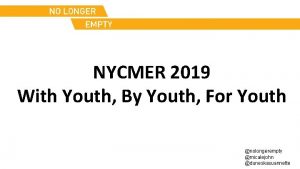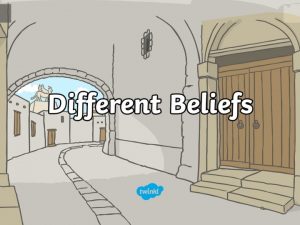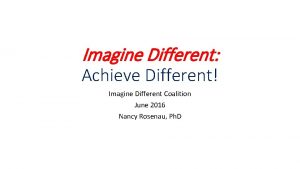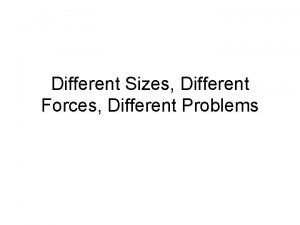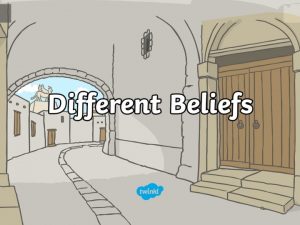Creating Inclusive Program Environments for Youth with Different






































































- Slides: 70

Creating Inclusive Program Environments for Youth with Different Abilities JUTTA DOTTERWEICH ACT FOR YOUTH CORNELL UNIVERSITY

Training Overview § Introductions & Objectives § Section 1: Including Youth with Different Abilities § Section 2: General Strategies to Create Inclusive Program Environments § Section 3: Promoting a Sense of Belonging § Section 4: Integrating Mindfulness and De-Stressing Activities § Section 5: Modeling and Teaching Empathy § Section 6: Addressing Challenging Behavior § Section 7: Disability Legislation, Accommodations, and Working with Community Partners

1. Including Youth with Different Abilities


“Hidden” or Undisclosed Disabilities Learning Disabilities Autism Spectrum Disorder ADHD Trauma

Learning Disabilities Youth with learning disabilities see, hear, and understand things differently. Common types of learning disabilities: -Dyslexia (reading) -Dyscalculia (math) -Dysgraphia (writing) -Dyspraxia (fine motor skills) -Dysphasia (spoken language)

What does it feel like? https: //www. dyslexia-readingwell. com/whoopi-goldberg. html

Get distracted easily and forget things Switch too quickly from one activity to next Have trouble with directions ADHD Challenges Have trouble finishing tasks Lose things Fidget and run around a lot Touch and play with everything they see Blurt out inappropriate comments Have trouble controlling their emotions Impulsivity Inconsistent Attention Hyperactivity

What does it feel like? https: //www. youtube. com/watch? v=NL 483 G 4 x. Ku 0

Autism Spectrum Disorder Impaired social interaction Difficulty in communication Tendency to have restricted range of interest

What does it feel like? https: //www. ted. com/talks/rosie_king_how_ autism_freed_me_to_be_myself#t-2281

http: //www. interactingwithautism. com/section/understanding/sensory/1 Source: Interacting with Autism http: //www. interactingwithautism. com/

Living with Trauma https: //americanspcc. org/adverse-childhood-experiences/

How childhood trauma affects health across a lifetime https: //www. ted. com/talks/nadine_burke_harris_how_c hildhood_trauma_affects_health_across_a_lifetime

Defining Trauma results from an event, series of events, or set of circumstances that is experienced by an individual as physically or emotionally harmful or life threatening and that has lasting adverse effects on the individual’s functioning and mental, physical, social, emotional, or spiritual well-being. SAMHSA 2014

Re-Traumatization A situation, attitude, interaction, or environment that replicates the events or dynamics of the original trauma and triggers the overwhelming feelings and reactions associated with them

Effects of Trauma Behavioral Effects Cognitive Effects Social Effects - Risk taking - Acting out - Rule breaking - - Attention Memory Executive functions Verbal abilities Skills development Language Group work Problem solve Transition Impulsivity Aggression Deviance Withdrawal Challenged relationships

Trauma. Informed Approach Safety Empower ment Trustworth iness Guiding Principles Collaborati on SAMHSA 2014 Choice Consider Culture, History, Gender

https: //www. template. net/design-templates/inspirational/sad-emoji/ Thinking about your youth programs what challenges could you expect?

Potential Challenges o Restlessness/Impulsivity o Aggression/Agitation o Withdrawal o Inattention o Immaturity

What is Our Role? Youth workers are “individuals who work with or on behalf of youth to facilitate their personal, social and education development and enable them to gain a voice, influence and place in society as they make the transition from dependence to independence” (Stone, Garza & Borden, 2004) We are positive role models!

2. General Strategies to Create Inclusive Program Environments

General Strategies o. UDL Guidelines o. Group agreements o. Power Cards o. Transparency and predictability o. Establishing a ‘Comfort Corner’

http: //udlguidelines. cast. org/

Group Agreements

Power Cards

Transparent & Predictable o. Schedules & Routines o. Ease transitions o. Room set up o. Calm Zone http: //micetimes. asia/the-most-unusual-bridges-from-aroundthe-world-photo/

What is a Comfort Corner?

3. Promoting a Sense of Belonging

Belonging Feeling like an accepted, valued, and legitimate group member https: //sites. google. com/site/hscbelongingstandar d/concepts-of-belonging/barriers-preventingbelonging

Promoting Belonging Promote belonging by changing the environment - Emphasize similarities - Practice inclusivity, participation, and mutual respect - Create formal and informal ways for youth and adults to learn about each other’s interests, aspirations and good things going on in their lives - Create a welcoming environment (incl. physical environment)

https: //www. edweek. org/ew/section/multimedia/illustration-microaggressions-in-the-classroom. html Beware of Microaggressions

Microaffirmations Harvard’s Research: Accentuate the Positive Nodding and making eye contact with youth while they’re talking Making sure to call on all youth equally Referring to every young person by their name Using inclusive language — for instance, talk about “families” instead of “parents” Openly giving praise for a wide-range of actions, from answering a question right to sitting still during a lesson Staying enthusiastic when interacting with youth https: //www. gse. harvard. edu/news/uk/16/12/accentuate-positive

Build on Strengths Identify interests, passions, talents, and aspirations

https: //www. uhs. umich. edu/mindfulness 4. Integrating Mindfulness and Destressing Activities

Mindfulness “paying attention on purpose in the present moment and non-judgmentally” Jon Kabat-Zinn. 2011 “Mindfulness is paying attention, here and now, with kindness and curiosity, so that we can choose our behavior” Amy Saltzman. 2014

Mindfulness Impacts Stress reduction Attention Positive self -concept Emotional control Positive Interactions

Mindfulness Tips Practice mindfulness yourself - Integrate a mindfulness activity into your own day - Use it to get ready for a program session Build it into your youth program - Make an activity part of the program routine - Encourage youth to practice on their own (at home, etc. ) To motivate – watch Le. Bron https: //www. youtube. com/watch? v=SCR 7 Of. Ru. Qd 4

Handling Stress/ Promoting Self-Regulation

Helping Youth Cope with Stress Coping Feelings Triggers Things I can do that help me feel better What does it make me feel like? Things that make me upset are… Sample tip sheet: http: //www. learnalberta. ca/content/insp/html/student/amiangry. pdf


Integrate Stress-Reducing Activities Relaxation exercises Physical activity Walks/activities in nature Creative/arts activities

Gracia Lam 5. Modeling and Teaching Empathy

Empathy vs Sympathy https: //www. youtube. com/watch? v= 1 Evwgu 369 Jw

Empathy – A Definition Ability to sense other people’s emotions, coupled with the ability to imagine what somebody else might be thinking or feeling. Affective empathy refers to the sensations and feelings we might get in response to other people’s emotions (e. g. , mirroring) Cognitive empathy refers to our ability to identify and understand other people’s emotions (perspective taking)

Modeling and Practicing Empathy Practice Kindness Active Listening Perspectiv e Taking

Non-Verbal Techniques • Silence • Eye Contact • Facial expression • Posture (e. g. , leaning forward) • Minimal encouragement (“uh-huh, ” go on, etc. ) • Tone of voice

Active Listening for meaning � Attentive to speaker � Reflecting facts and feelings � Interpreting meaning, feelings � Withholding opinions and judgment

Poster https: //downloads. rand omactsofkindness. org/R AK_kindness_poster. jpg Source: https: //www. randomactsofkindness. org/

http: //www. actforyouth. net/youth_development/professionals/sel/

https: //sites. google. com/site/bcbaservice/ho me/aba-therapy/challenging-behaviors 6. Addressing Challenging Behavior

Self Reflection Activity

A New Behavior Perspective Misbehavior is a symptom of an underlying cause Behavior is communication Behavior has a function Behavior occurs in patterns Behavior can be changed Only behavior an adult can control is her own

Behavior Analysis Look for behavior patterns Antecedents – Behavior – Consequences Identify behavior goals Attention, escape, etc. Teach underdeveloped skills Self-regulation, social skills, executive functions (self-control), flexible thinking

Environmental Scan & De-Escalation Assess and Address Environment Lighting Noise level Time of day (arrival, after breaks) Community settings – crowds, noise, activity level Read Early Warning Signs Tense body language, pacing, louder voice, sudden behavior change → check-in with youth

Keep in Mind…When Stressed Meaning = Facial + Expression 55% Tone of Voice 38% + Words 7%

Behavior Management Techniques q. Proximity q. Prompts q. Hurdle help q. Time away q. Redirection q. Directive statements q. Caring gesture

7. Disability Legislation, Accommodations and Working with Community Partners

Defining Disability Disabilities affect people’s daily functioning, work, social relationships and participation in public life. Disabilities can be §Physical §Learning §Sensory §Mental health condition §Developmental §Health condition §Intellectual

Important Disability Legislation Individuals with Disabilities in Education Act (IDEA) Americans with Disabilities Act (ADA) Protect • Discrimination • Abuse Provide • Additional services • Accommodations

Accommodations An accommodation is essentially any strategy that overcomes or lessens the effect of a specific barrier. A barrier is an obstacle that may exist in school, at the workplace, in the community, or in one’s own home. Accommodations ◦ Changes to facilities ◦ Special services ◦ Creative thinking and problem solving

Unit 4 Individuals with Disabilities in Education Act (IDEA) IDEA covers ages: Birth - 21 Thirteen Categories: Autism, Deaf-blindness, Deafness, Emotional Disturbance, Hearing impairment, Mental retardation, Multiple disabilities, Orthopedic impairment, Other health impairment, Specific learning disability, Speech or language impairment, Traumatic brain injury, Visual impairment

IDEA Impact on Education Free public education Quality instruction Testing to establish needs and services Individual education plan (IEP) Specialty support or accommodations Accommodations can include Verbal instructions Visuals Additional test time

Americans with Disabilities Act (ADA) A person qualifies as having a disability if they meet one of the following: ◦ A physical or mental impairment that substantially limits one or more major life activities ◦ A record of such impairment ◦ A perception by others as having an impairment

Accommodations are provided only when a person discloses his or her disability and requests accommodations. Disclosure is not mandatory, but needed when asking for accommodations. Decision to disclose belongs solely to the person with a disability They are not considered reasonable if they represent “undue burden” or fundamentally alter the program.

COMMUNITY NEEDS MAP Unemployment Gangs Domestic Abuse Single Parent Families Dilapidated Housing Teen Pregnancy Mental Child Abuse Crime Disability Illiteracy Alcohol & Drug Abuse Juvenile Delinquency Poverty Homelessness Suicide & Depression

NEEDS Focuses on deficiencies ASSETS Focuses on effectiveness Results in fragmentation of responses Builds interdependencies to local needs Makes people consumer of services; builds dependence Identifies ways that people can give their talents Residents have little voices in deciding how to address local concerns Seeks to empower people

COMMUNITY ASSETS MAP Local Institutions HOSPITALS GOVERNMENT Citizens’ Associations BUSINESS CHURCHES INCOME YOUTH PARKS BLOCK CLUBS Gifts of SKILLS Individuals ELDERLY DIFFERENTLY ABLED PEOPLE CULTURAL CLUBS LIBRARIES SCHOOLS HUMAN SERVICE AGENCIES COLLEGES

Resources http: //www. actforyouth. net/youth_development/professionals/inclusive-environments. cfm

Wrapping Up I feel… I learned… I never knew… I now understand… I wish… I’m glad that… I appreciate
 Creating supportive environments smoking
Creating supportive environments smoking Story openers
Story openers What is the correct steps in creating a parallel program
What is the correct steps in creating a parallel program What is the correct steps in creating a parallel program
What is the correct steps in creating a parallel program The widening set of interdependent relationships
The widening set of interdependent relationships Machine reference model in cloud computing
Machine reference model in cloud computing Business and its environment are
Business and its environment are Chapter 13 natural environments of europe
Chapter 13 natural environments of europe Stable prediction across unknown environments
Stable prediction across unknown environments Psychologically informed environments
Psychologically informed environments Psychologically informed environments
Psychologically informed environments High quality supportive environments
High quality supportive environments External environment and accountability of schools
External environment and accountability of schools Model-based reflex agents examples
Model-based reflex agents examples Chapter 13 natural environments of europe
Chapter 13 natural environments of europe Jonassen constructivist learning environment
Jonassen constructivist learning environment World geography
World geography Economic activity
Economic activity Relationship between micro macro and market environment
Relationship between micro macro and market environment Ans0361i
Ans0361i The marketing environment is the actors and forces outside
The marketing environment is the actors and forces outside Implations
Implations International marketing environment
International marketing environment International business environments and operations
International business environments and operations Diverse learning environments survey
Diverse learning environments survey Enabling environments eyfs
Enabling environments eyfs International business environments and operations
International business environments and operations Exercise in hot and cold environments
Exercise in hot and cold environments International business environments and operations
International business environments and operations Diverse learning environments survey
Diverse learning environments survey Wioa youth program elements
Wioa youth program elements Presidential youth fitness program
Presidential youth fitness program District 71 toastmasters
District 71 toastmasters American red cross leadership
American red cross leadership Oregon youth transition program
Oregon youth transition program Fspos
Fspos Typiska drag för en novell
Typiska drag för en novell Nationell inriktning för artificiell intelligens
Nationell inriktning för artificiell intelligens Ekologiskt fotavtryck
Ekologiskt fotavtryck Varför kallas perioden 1918-1939 för mellankrigstiden?
Varför kallas perioden 1918-1939 för mellankrigstiden? En lathund för arbete med kontinuitetshantering
En lathund för arbete med kontinuitetshantering Kassaregister ideell förening
Kassaregister ideell förening Tidbok yrkesförare
Tidbok yrkesförare Anatomi organ reproduksi
Anatomi organ reproduksi Vad är densitet
Vad är densitet Datorkunskap för nybörjare
Datorkunskap för nybörjare Boverket ka
Boverket ka Debatt mall
Debatt mall Delegerande ledarstil
Delegerande ledarstil Nyckelkompetenser för livslångt lärande
Nyckelkompetenser för livslångt lärande Påbyggnader för flakfordon
Påbyggnader för flakfordon Arkimedes princip formel
Arkimedes princip formel Publik sektor
Publik sektor Bo bergman jag fryser om dina händer
Bo bergman jag fryser om dina händer Presentera för publik crossboss
Presentera för publik crossboss Teckenspråk minoritetsspråk argument
Teckenspråk minoritetsspråk argument Vem räknas som jude
Vem räknas som jude Treserva lathund
Treserva lathund Epiteltyper
Epiteltyper Bästa kameran för astrofoto
Bästa kameran för astrofoto Cks
Cks Lågenergihus nyproduktion
Lågenergihus nyproduktion Mat för idrottare
Mat för idrottare Verktyg för automatisering av utbetalningar
Verktyg för automatisering av utbetalningar Rutin för avvikelsehantering
Rutin för avvikelsehantering Smärtskolan kunskap för livet
Smärtskolan kunskap för livet Ministerstyre för och nackdelar
Ministerstyre för och nackdelar Tack för att ni har lyssnat
Tack för att ni har lyssnat Mall för referat
Mall för referat Redogör för vad psykologi är
Redogör för vad psykologi är Stål för stötfångarsystem
Stål för stötfångarsystem
